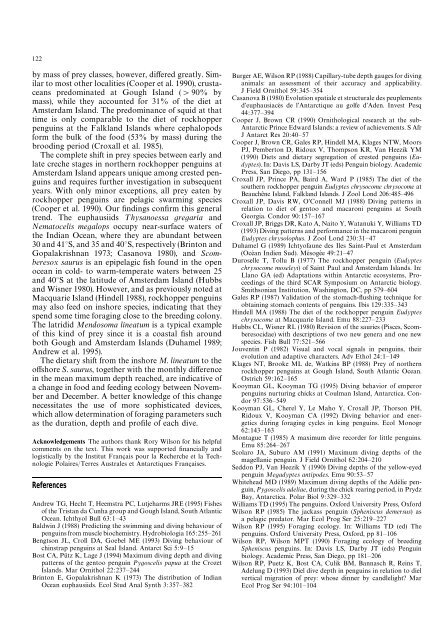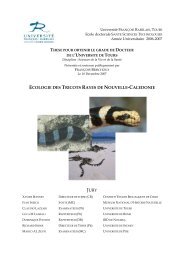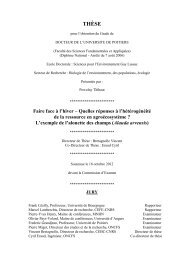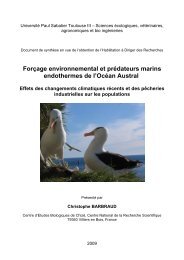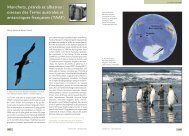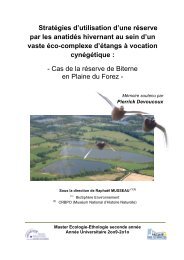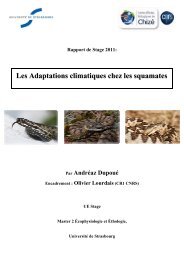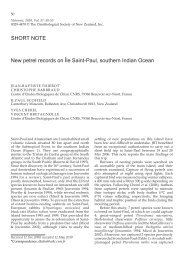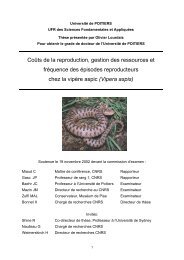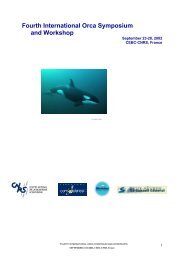Maximum diving depths of northern rockhopper penguins ... - CEBC
Maximum diving depths of northern rockhopper penguins ... - CEBC
Maximum diving depths of northern rockhopper penguins ... - CEBC
Create successful ePaper yourself
Turn your PDF publications into a flip-book with our unique Google optimized e-Paper software.
122<br />
by mass <strong>of</strong> prey classes, however, differed greatly. Similar<br />
to most other localities (Cooper et al. 1990), crustaceans<br />
predominated at Gough Island ('90% by<br />
mass), while they accounted for 31% <strong>of</strong> the diet at<br />
Amsterdam Island. The predominance <strong>of</strong> squid at that<br />
time is only comparable to the diet <strong>of</strong> <strong>rockhopper</strong><br />
<strong>penguins</strong> at the Falkland Islands where cephalopods<br />
form the bulk <strong>of</strong> the food (53% by mass) during the<br />
brooding period (Croxall et al. 1985).<br />
The complete shift in prey species between early and<br />
late creche stages in <strong>northern</strong> <strong>rockhopper</strong> <strong>penguins</strong> at<br />
Amsterdam Island appears unique among crested <strong>penguins</strong><br />
and requires further investigation in subsequent<br />
years. With only minor exceptions, all prey eaten by<br />
<strong>rockhopper</strong> <strong>penguins</strong> are pelagic swarming species<br />
(Cooper et al. 1990). Our findings confirm this general<br />
trend. The euphausiids ¹hysanoessa gregaria and<br />
Nematocelis megalops occupy near-surface waters <strong>of</strong><br />
the Indian Ocean, where they are abundant between<br />
30 and 41°S, and 35 and 40°S, respectively (Brinton and<br />
Gopalakrishnan 1973; Casanova 1980), and Scomberesox<br />
saurus is an epipelagic fish found in the open<br />
ocean in cold- to warm-temperate waters between 25<br />
and 40°S at the latitude <strong>of</strong> Amsterdam Island (Hubbs<br />
and Wisner 1980). However, and as previously noted at<br />
Macquarie Island (Hindell 1988), <strong>rockhopper</strong> <strong>penguins</strong><br />
may also feed on inshore species, indicating that they<br />
spend some time foraging close to the breeding colony.<br />
The latridid Mendosoma lineatum is a typical example<br />
<strong>of</strong> this kind <strong>of</strong> prey since it is a coastal fish around<br />
both Gough and Amsterdam Islands (Duhamel 1989;<br />
Andrew et al. 1995).<br />
The dietary shift from the inshore M. lineatum to the<br />
<strong>of</strong>fshore S. saurus, together with the monthly difference<br />
in the mean maximum depth reached, are indicative <strong>of</strong><br />
a change in food and feeding ecology between November<br />
and December. A better knowledge <strong>of</strong> this change<br />
necessitates the use <strong>of</strong> more sophisticated devices,<br />
which allow determination <strong>of</strong> foraging parameters such<br />
as the duration, depth and pr<strong>of</strong>ile <strong>of</strong> each dive.<br />
Acknowledgements The authors thank Rory Wilson for his helpful<br />
comments on the text. This work was supported financially and<br />
logistically by the Institut Franiais pour la Recherche et la Technologie<br />
Polaires/Terres Australes et Antarctiques Franiaises.<br />
References<br />
Andrew TG, Hecht T, Heemstra PC, Lutjeharms JRE (1995) Fishes<br />
<strong>of</strong> the Tristan da Cunha group and Gough Island, South Atlantic<br />
Ocean. Ichthyol Bull 63:1—43<br />
Baldwin J (1988) Predicting the swimming and <strong>diving</strong> behaviour <strong>of</strong><br />
<strong>penguins</strong> from muscle biochemistry. Hydrobiologia 165:255—261<br />
Bengtson JL, Croll DA, Goebel ME (1993) Diving behaviour <strong>of</strong><br />
chinstrap <strong>penguins</strong> at Seal Island. Antarct Sci 5:9—15<br />
Bost CA, Pu¨ tz K, Lage J (1994) <strong>Maximum</strong> <strong>diving</strong> depth and <strong>diving</strong><br />
patterns <strong>of</strong> the gentoo penguin Pygoscelis papua at the Crozet<br />
Islands. Mar Ornithol 22:237—244<br />
Brinton E, Gopalakrishnan K (1973) The distribution <strong>of</strong> Indian<br />
Ocean euphausiids. Ecol Stud Anal Synth 3:357—382<br />
Burger AE, Wilson RP (1988) Capillary-tube depth gauges for <strong>diving</strong><br />
animals: an assessment <strong>of</strong> their accuracy and applicability.<br />
J Field Ornithol 59:345—354<br />
Casanova B (1980) Evolution spatiale et structurale des peuplements<br />
d’euphausiacés de l’Antarctique au golfe d’Aden. Invest Pesq<br />
44:377—394<br />
Cooper J, Brown CR (1990) Ornithological research at the sub-<br />
Antarctic Prince Edward Islands: a review <strong>of</strong> achievements. S Afr<br />
J Antarct Res 20:40—57<br />
Cooper J, Brown CR, Gales RP, Hindell MA, Klages NTW, Moors<br />
PJ, Pemberton D, Ridoux V, Thompson KR, Van Heezik YM<br />
(1990) Diets and dietary segregation <strong>of</strong> crested <strong>penguins</strong> (Eudyptes).<br />
In: Davis LS, Darby JT (eds) Penguin biology. Academic<br />
Press, San Diego, pp 131—156<br />
Croxall JP, Prince PA, Baird A, Ward P (1985) The diet <strong>of</strong> the<br />
southern <strong>rockhopper</strong> penguin Eudyptes chrysocome chrysocome at<br />
Beaucheˆ ne Island, Falkland Islands. J Zool Lond 206:485—496<br />
Croxall JP, Davis RW, O’Connell MJ (1988) Diving patterns in<br />
relation to diet <strong>of</strong> gentoo and macaroni <strong>penguins</strong> at South<br />
Georgia. Condor 90:157—167<br />
Croxall JP, Briggs DR, Kato A, Naito Y, Watanuki Y, Williams TD<br />
(1993) Diving patterns and performance in the macaroni penguin<br />
Eudyptes chrysolophus. J Zool Lond 230:31—47<br />
Duhamel G (1989) Ichty<strong>of</strong>aune des Iles Saint-Paul et Amsterdam<br />
(Océan Indien Sud). Mésogée 49:21—47<br />
Duroselle T, Tollu B (1977) The <strong>rockhopper</strong> penguin (Eudyptes<br />
chrysocome moseleyi) <strong>of</strong> Saint Paul and Amsterdam Islands. In:<br />
Llano GA (ed) Adaptations within Antarctic ecosystems, Proceedings<br />
<strong>of</strong> the third SCAR Symposium on Antarctic biology.<br />
Smithsonian Institution, Washington, DC, pp 579—604<br />
Gales RP (1987) Validation <strong>of</strong> the stomach-flushing technique for<br />
obtaining stomach contents <strong>of</strong> <strong>penguins</strong>. Ibis 129:335—343<br />
Hindell MA (1988) The diet <strong>of</strong> the <strong>rockhopper</strong> penguin Eudyptes<br />
chrysocome at Macquarie Island. Emu 88:227—233<br />
Hubbs CL, Wisner RL (1980) Revision <strong>of</strong> the sauries (Pisces, Scomberesocidae)<br />
with descriptions <strong>of</strong> two new genera and one new<br />
species. Fish Bull 77:521—566<br />
Jouventin P (1982) Visual and vocal signals in <strong>penguins</strong>, their<br />
evolution and adaptive characters. Adv Ethol 24:1—149<br />
Klages NT, Brooke ML de, Watkins BP (1988) Prey <strong>of</strong> <strong>northern</strong><br />
<strong>rockhopper</strong> <strong>penguins</strong> at Gough Island, South Atlantic Ocean.<br />
Ostrich 59:162—165<br />
Kooyman GL, Kooyman TG (1995) Diving behavior <strong>of</strong> emperor<br />
<strong>penguins</strong> nurturing chicks at Coulman Island, Antarctica. Condor<br />
97:536—549<br />
Kooyman GL, Cherel Y, Le Maho Y, Croxall JP, Thorson PH,<br />
Ridoux V, Kooyman CA (1992) Diving behavior and energetics<br />
during foraging cycles in king <strong>penguins</strong>. Ecol Monogr<br />
62:143—163<br />
Montague T (1985) A maximum dive recorder for little <strong>penguins</strong>.<br />
Emu 85:264—267<br />
Scolaro JA, Suburo AM (1991) <strong>Maximum</strong> <strong>diving</strong> <strong>depths</strong> <strong>of</strong> the<br />
magellanic penguin. J Field Ornithol 62:204—210<br />
Seddon PJ, Van Heezik Y (1990) Diving <strong>depths</strong> <strong>of</strong> the yellow-eyed<br />
penguin Megadyptes antipodes. Emu 90:53—57<br />
Whitehead MD (1989) <strong>Maximum</strong> <strong>diving</strong> <strong>depths</strong> <strong>of</strong> the Adélie penguin,<br />
Pygoscelis adeliae, during the chick rearing period, in Prydz<br />
Bay, Antarctica. Polar Biol 9:329—332<br />
Williams TD (1995) The <strong>penguins</strong>. Oxford University Press, Oxford<br />
Wilson RP (1985) The jackass penguin (Spheniscus demersus) as<br />
a pelagic predator. Mar Ecol Prog Ser 25:219—227<br />
Wilson RP (1995) Foraging ecology. In: Williams TD (ed) The<br />
<strong>penguins</strong>. Oxford University Press, Oxford, pp 81—106<br />
Wilson RP, Wilson MPT (1990) Foraging ecology <strong>of</strong> breeding<br />
Spheniscus <strong>penguins</strong>. In: Davis LS, Darby JT (eds) Penguin<br />
biology. Academic Press, San Diego, pp 181—206<br />
Wilson RP, Puetz K, Bost CA, Culik BM, Bannasch R, Reins T,<br />
Adelung D (1993) Diel dive depth in <strong>penguins</strong> in relation to diel<br />
vertical migration <strong>of</strong> prey: whose dinner by candlelight? Mar<br />
Ecol Prog Ser 94:101—104


